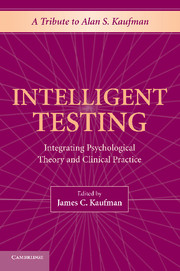Book contents
- Frontmatter
- Contents
- Acknowledgments
- Alphabetical List of Authors and Affiliations
- PART ONE THOSE WHO KNOW HIM
- PART TWO INTELLIGENT TESTING
- 4 Intelligent Testing: Bridging the Gap between Classical and Romantic Science in Assessment
- 5 The Intelligent Testing of Children with Specific Learning Disabilities
- 6 Temperament Preferences for Children Ages 8 Through 17 in a Nationally Represented Sample
- 7 Intelligent Intelligence Testing: The Influence of Alan S. Kaufman
- PART THREE THE INTERSECTION OF THEORY AND MEASUREMENT
- PART FOUR KAUFMAN ACROSS THE WORLD
- Author Index
- Subject Index
- References
5 - The Intelligent Testing of Children with Specific Learning Disabilities
Published online by Cambridge University Press: 05 August 2012
- Frontmatter
- Contents
- Acknowledgments
- Alphabetical List of Authors and Affiliations
- PART ONE THOSE WHO KNOW HIM
- PART TWO INTELLIGENT TESTING
- 4 Intelligent Testing: Bridging the Gap between Classical and Romantic Science in Assessment
- 5 The Intelligent Testing of Children with Specific Learning Disabilities
- 6 Temperament Preferences for Children Ages 8 Through 17 in a Nationally Represented Sample
- 7 Intelligent Intelligence Testing: The Influence of Alan S. Kaufman
- PART THREE THE INTERSECTION OF THEORY AND MEASUREMENT
- PART FOUR KAUFMAN ACROSS THE WORLD
- Author Index
- Subject Index
- References
Summary
INTRODUCTION
The category of specific learning disabilities (SLD) encompasses a heterogeneous group of disorders that adversely impacts the development of some aspect of academic functioning and proficiency. Although few doubt the existence of SLD, a lack of consensus regarding definition, as well as a failure to resolve various identification and treatment issues, has plagued the field since its inception. One major area of controversy is the use of intelligence tests for the identification of individuals with SLD (Kaufman & Kaufman, 2001). During the last four decades, the work and writings of Dr. Alan Kaufman, in association with his wife, Dr. Nadeen Kaufman, have helped to clarify, refine, and substantiate the most efficacious ways intelligence tests can and should be used with individuals having or suspected of having SLD. The purpose of this chapter is to discuss various aspects of their contributions that have had particular relevance to and impact on the field of learning disabilities through my own perspective. The chapter includes discussion of several issues that have affected SLD identification and assessment procedures, as well as consideration of the most pragmatic and valid processes and procedures for diagnosing SLD.
- Type
- Chapter
- Information
- Intelligent TestingIntegrating Psychological Theory and Clinical Practice, pp. 30 - 52Publisher: Cambridge University PressPrint publication year: 2009
References
- 2
- Cited by



